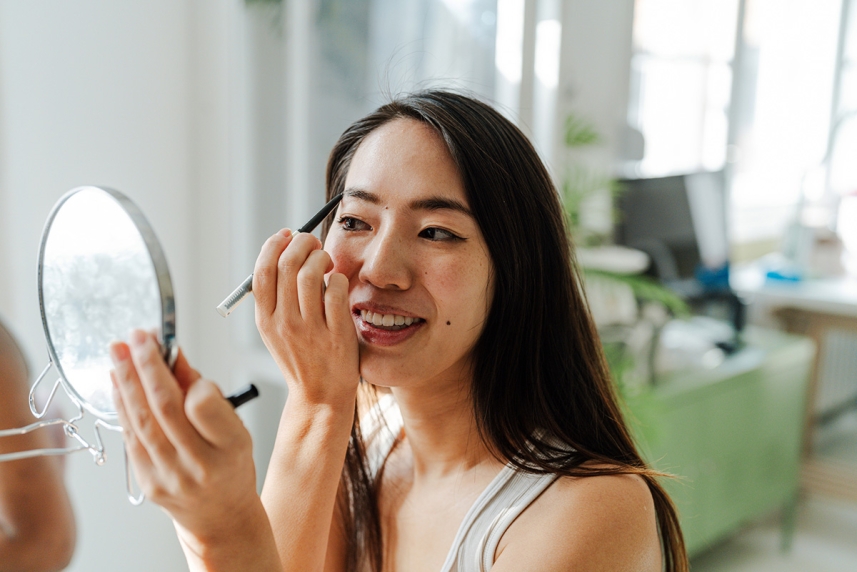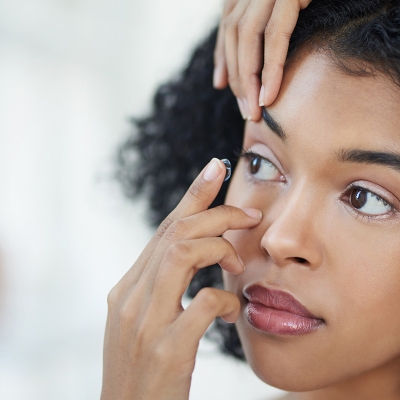10 tips for applying makeup when wearing contact lenses
Learn how a contact-lens wearer can safely (and smartly) put it on and keep their eyes healthy.

Adults and teenagers may wear makeup to work or on special occasions. But if a person also wears contact lenses, wearing makeup might be something they want to do with care.
Contact lenses sit on the top layer of the eye.1 If makeup were to get on them, it could lead to eye-related issues, some more serious than others.
Here are tips to help a person safely put on makeup while wearing contact lenses.
Running low on your favorite hard or soft contacts? Order a new supply online today.
10 tips for applying makeup while wearing contact lenses
Enjoy wearing makeup and contact lenses? Here are some ways to do so safely:
1. Wash and dry the hands.
Before makeup is put on or contact lenses are put in, be sure to wash and dry the hands.1 This can stop bacteria from going from a person's hands to their makeup and then their contact lenses.
2. Don’t splash water in the eyes.
Don’t get water in the eyes while contact lenses are in. Water may have bacteria, viruses and amoebas (microscopic animals) in it. This can lead to eye infections.1
3. Insert contact lenses before using makeup.
Insert contact lenses before applying any makeup to the face.3 This is so a person doesn’t touch their contacts with makeup. That may lead to eye irritation.
4. Use hypoallergenic, unscented makeup.
Use makeup that’s unscented and hypoallergenic from trusted sources and brands.2 (That means they have little chance of causing an allergic reaction.) That will lower the person’s risk of experiencing eye irritation.
5. Wash all makeup brushes.
Clean makeup brushes every 7 to 10 days to keep them free from bacteria. According to the American Academy of Dermatology Association, here’s how they may do so:4
- Rinse the brush tips under lukewarm, running water.
- Swirl each brush tip in a bowl with lukewarm water and a tablespoon of gentle or clarifying shampoo.
- Rinse the brush tips under running water.
- Continue to swirl and rinse until the water on the brush runs clear.
- Squeeze out extra moisture with a clean, dry paper towel.
- Lay the brush flat to dry on a towel with the tips hanging off the edge of the counter.
6. Don’t use old mascara applicators.
It’s not a good idea to use old applicators with refills. They may have bacteria in them.2
7. Don’t use water or saliva to wet an applicator.
Don’t use water or saliva to wet applicators, like makeup brushes.2 This can bring bacteria to the products. That can then transfer to their contact lenses or eyes.
8. Be picky about powders and creams.
Try not to use loose powders on the face and creams near the eyes. They can get onto contact lenses or into the eyes.5
9. Don’t use certain types of eye shadow.
Steer clear from the following types of eye shadow when wearing contacts:2
- Frosted
- Glittery
- Iridescent (color changing)
- Pearlized
They can flake into the eyes and cause irritation.5
10. Be careful with eyeliner placement.
It’s not a good idea to put eyeliner on the inner edge of the eyelid or above the eyelash line on the lower lid.5 This could cause eye irritation and infection.
When should a person not wear makeup and/or contact lenses at all?
If a person has any of these symptoms, it isn’t a good idea to wear contacts or makeup:1,5
- Discharge (fluid leaking out of the eyes)
- Eye pain
- Infected eyes
- Light sensitivity
- Red eyes
- Sudden blurry vision
- Swollen eyes
- Unusually watery eyes
It’s important to talk to an eye care provider if any of these symptoms don’t go away or get worse.
How can a person get contact lenses?
A person can buy makeup nearly anywhere. But that’s not true of contact lenses.
They will first need to get an updated contact lens prescription. They can do that by scheduling their annual eye exam with their eye care provider. They may also need a follow-up contact lens fitting.6
Once they have an updated prescription, a person can use it to order new contact lenses. If they are a UnitedHealthcare Vision member, they typically have an allowance for contact lenses. They may also receive discounts for ordering contacts online. Check the UnitedHealthcare Vision website for current discounts.
Sources:
- Contact lenses National Eye Institute, December 2024
- Cosmetic safety for teen contact lens wearers Stanford Medicine
- Prevent blindness warns public about the dangers of misusing contact lenses and the potential for damage to the eye Prevent Blindness, September 2023
- How to clean your makeup brushes American Academy of Dermatology Association
- Cosmetic safety for contact lens wearers Johns Hopkins Medicine
- Buying prescription glasses or contact lenses: Your rights Federal Trade Commission, June 2024


